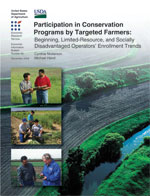Participation in Conservation Programs by Targeted Farmers: Beginning, Limited-Resource, and Socially Disadvantaged Operators' Enrollment Trends
- by Cynthia Nickerson and Michael S. Hand
- 12/7/2009
Overview
Beginning, limited-resource, and socially disadvantaged farmers make up as much as 40 percent of all U.S. farms. Some Federal conservation programs contain provisions that encourage participation by such "targeted" farmers and the 2008 Farm Act furthered these efforts. This report compares the natural resource characteristics, resource issues, and conservation treatment costs on farms operated by targeted farmers with those of other participants in the largest U.S. working-lands and land retirement conservation programs. Some evidence shows that targeted farmers tend to operate more environmentally sensitive land than other farmers, have different conservation priorities, and receive different levels of payments. Data limitations preclude a definitive analysis of whether efforts to improve participation by targeted farmers hinders or enhances the conservation programs' ability to deliver environmental benefits cost effectively. But the different conservation priorities among types of farmers suggest that if a significantly larger proportion of targeted farmers participates in these programs, the programs' economic and environmental outcomes could change.
Download
-
Entire report
Download PDF -
Report summary
Download PDF -
Download EIB62.zip
Download ZIP

